WITCHES AND BREBAS
/1 Comment/in Flowers, Fruit, Gardening, Pruning/by Lee ReichArnold, You’re Too Big
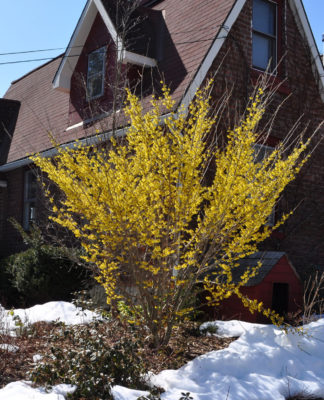
Witchhazel, a few weeks ago
Over the years, my Arnold’s Promise variety of witchhazel has earned its keep with branches showered in fragrant, golden flowers late each winter. Some years, like last year, part of the bush would blossom in autumn, then put on a repeat performance in late winter. (Branches that blossom in autumn don’t blossom again in later winter, but other branches, which hold off in autumn, do.)
I should have read the fine print more carefully before I selected this variety of witchhazel. My plan was for the plant to visually smooth the transition from the corner of the house to an upright stewartia tree to a moderate-sized shrub (Arnold’s Promise) to some subshrubs (lowbush blueberry) to ground level. Except that Arnold’s Promise has grown to 15 feet high. Which it’s supposed to do, according to the fine print. Which I didn’t read.
My job, now, is to bring the shrub to more comely proportions for the site, by pruning. Like other shrubs, witchhazels can be pruned by a renewal method, cutting to the ground the oldest stems and thinning out the number of youngest stems. The pruned plant, then, always has a spectrum of various aged stems, none of them too old or too overcrowded.
What makes an “old” stem for a shrub depends on its growth habit. For raspberries, two year old stems are “old,” so old that they die. And they make lots of young stems that need ruthless thinning out.
Witchhazels are at the other extreme. Very old stems keep sporting flowers, and the shrubs typically send up very few young stems. So witchhazels need very little pruning.
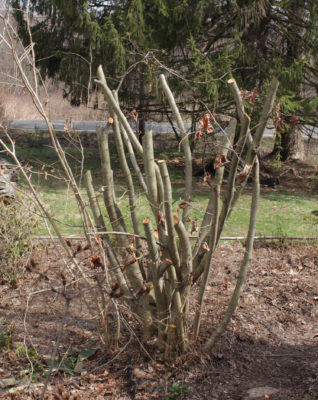
Witchhazel, partially pruned
At first, I was going to renew Arnold’s Promise over the course of a few years, removing some of the oldest stems each year and hoping for younger replacements. That would let the shrub put on a nice show each year.
But once I get started pruning, restraint is difficult. I was tempted to cut every stem, young and old, to the ground, then decide, as growth began, which young stems to save to build up the shrub again. I mostly did that, but saved a couple of small stems for a few blossoms this autumn or late next winter.
Especially this time of year, no matter what you do, you’re unlikely to kill a shrub by pruning. And, since they’re always growing new stems from ground level, even mistakes can be eventually corrected. (More about all this in my book, The Pruning Book).
A Reprieve For Arnold
Of course, I could kill Arnold’s Promise and plant a smaller variety of witchhazel, such as Little Suzie or Pallida. The latter’s flowers are reputedly especially fragrant. Then again, it reputedly grows 10 feet high — not that much smaller than Arnold’s Promise. Little Suzie, though, is billed at reaching only 5 or 6 feet tall.
For now, I’ll try pruning to cut Arnold’s Promise down to size.
Breba Figs are Swell(ing)
I can’t leave pruning yet. Figs. These plants have a most interesting and unique flowering and fruiting habit. Some varieties bear on one-year-old stems; some on new stems; and some on both.
I was pleasantly reminded of all this as I stepped into the greenhouse and looked up at the couple of full-length stems I had left after last autumn’s pruning of San Piero fig. San Piero is one of those varieties that bears on both one-year-old and new stems. New figs, the size of a quarter were already getting plump way up at at the tippy top of the full-length stems. If all goes well, these figs — called the breba crop — will ripen in midsummer.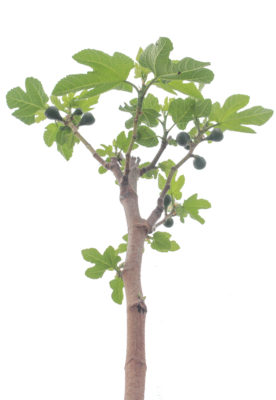
To reap that breba crop, one-year-old stems must survive winter weather. Which they do in my cool-temperature greenhouse, as well as where winter temperatures hardly dip below freezing. Where winters are cold, breba figs can be harvested from plants grown in pots and moved to a cool, but not frigid, location for winter, such as a barely heated garage or a mudroom (no light necessary). Or, in late autumn, stems can be bent to the ground and covered with plastic, to shed excess moisture, and then leaves, straw, or some other insulating material. Or, in even colder climates, bent down into a covered trench. (Fig trees are very flexible, literally and figuratively.)
My non-breba-forming figs and all except those few long stems I left on San Piero get drastic pruning. Everything, except for those one-year-old stems to save, gets pruned down to about 3 feet high. This pruning stimulates lots of new, vigorous shoots which bear the “main” crop, in late summer and on into autumn. Unlike apples, peaches, and other familiar fruits, main crop figs keep ripening over a long period, as long as the new shoots have enough light and warmth to keep growing.
HOUSEPLANTS THRIVE DURING MY CUBAN GETAWAY
/2 Comments/in Flowers, Gardening, Houseplants, Planning/by Lee Reich
Water In Air, In Soil, In Reserve
My houseplants enjoyed my absence more that I expected. I thought it might be harder on them. After all, with spring in the air (indoors) for a few weeks now, they were all pushing out new shoots from the ends and along stems that had lain dormant all winter. Citrus, avocado, and amaryllis were even flowering, and rosemary was getting ready to flower.
Lack of water was going to be the threat, 5 days of it, while I was far away wandering up and down streets and in and out of alleys of Havana, Cuba.
Through winter, I had eased my houseplant watering chores by using “water siphons” (aka “hydrospikes” or “self-watering probes”). These porous ceramic probes, filled with water and pushed into the potting soil, have the thin, flexible tubes coming out of their caps plunked into mason jars filled with water. I knew well just how thirsty the plants were, watching the water in the reservoirs into which the tubes that connect to the ceramic cones drop daily, in some cases a cup or more per day.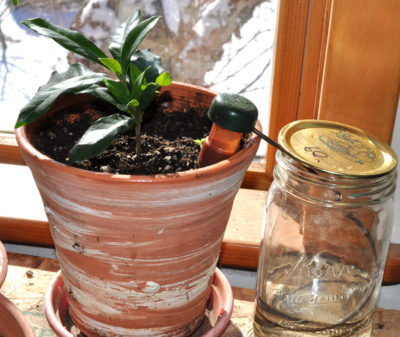
Plants cool off by letting water evaporate through little holes in their leaves, called stomates. So leaving the house thermostat set to cooler temperature was going to help slow water loss.
Evaporation is faster, whether through stomates or from the potting soil, the drier the air. Heat from radiators is less drying than that from the wood stove, our usual source of heat — also helping plants that might be pining away in my absence.
I poured water into the saucers in which each pot sits. As this water evaporates it creates a microclimate around nearby plants, a microclimate slightly more humid than that of the rest of the house, cutting down water loss from the potting soil and through the leaves. The humid microclimate was made more so by cozying plants in a cluster right up next to each other. Pebbles in the saucers bumped up this benefit by increasing the evaporative surface area.
To further help plants through their period of neglect, I filled the saucers with more water than usual, with the water level a smidgen above the bottom of the pots. As the potting mix dried, it could suck this water into the pot by capillary action. I don’t usually let water sit in the saucers above the level of the bottom of any resident pot because then the bottom of the pot becomes waterlogged, eventually leading to dead roots. I figured a few days would do no harm, and surely less harm than would drying out of the whole plant.
My final ministration was to cut open a clear dry cleaner bag and drape it loosely over the clusters of plants to maintain even higher humidity.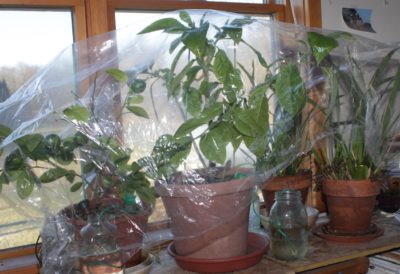
The upshot: The plants did not miss me even a little. They looked healthy and happy upon my return, perhaps even more so than with five days of constant attention!
Visitando El Jardín Botánico Nacional
One day in Cuba I ventured beyond Havana for a tour of the Jardín Botánico Nacional, or National Botanical Garden, which is adjacent to Parque Lenin (Vladimir, not John) Park. We bounced along on a tractor-pulled wagon through a landscape devoted to plants native to Cuba, then on into a savannah of plants of African origin, to groupings of plants indigenous to Latin America, and on through other tropical climates and ecosystems.
A few greenhouses there create special environments. One was a tropical rainforest greenhouse, with humidity kept high with frequent, automatic watering. A houseplant such as maranta formed an expansive groundcover there, and other familiar houseplants, such as peperomia, philodendron, begonia,, and spathiphyllum, either spread all over the ground or reached heights you would never see in a house.
A dry greenhouse, the covering, this time, to shed rainfall, was home to succulents and cactii. One cactus that caught my attention, especially so with Cuba’s connection to the Soviet Union, was the “Russian soldier cactus.” The upper portion of this upright cactus was furry and brown, just like a Russian soldier’s hat. (As far as cool, common names the Cubans have for plants, another one was “tourist tree,” so-named for its red, peeling bark, just like the skin of pale tourists that get too much tropical sun.)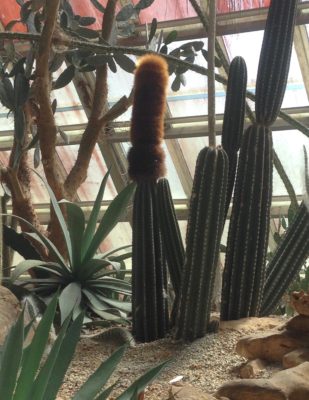
Another Orchid!?
I’m very happy with my two orchid plants — Dendrobium kingianum, the pink rock orchid, and Odontoglossum pulchellum, lily-of-the-valley orchid. Both bloom reliably once a year, in winter, for over a month.
But one of the orchids at the Jardín Botánico Nacional caught my attention for more than its beauty. Spathoglotis plicata, sometimes called Phillipine ground orchid, blossoms all year ‘round. It’s a terrestrial orchid that’s also easy to grow, not needing an excess of light. I’m going to get one to add to my collection.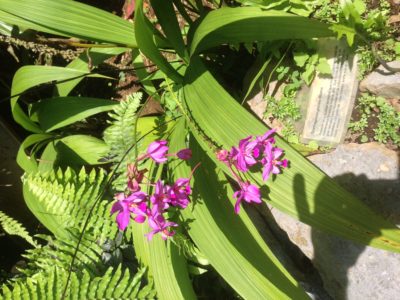
Orchids can become an obsession; I hope I’m not about to fall down a rabbit hole.
BLEEDING PLANTS, WHAT ABOUT RABBITS?
/1 Comment/in Gardening, Pruning/by Lee Reich
Bleeding Is Okay
Everyone wants to prune this time of year. And rightly so. It’s a good time to prune most trees, shrubs, and vines, as it was a couple of months ago and, looking forward, will be until about when these plants come into bloom. Or, finished blooming, in the case of those plants whose pruning gets delayed until after we all get to enjoy their early blossoms.
A reader wrote me about her Japanese maple, which needed to have one of its multi-trunks cut off. Should she do it now or in autumn? If lopped back now, would the tree bleed to death? Would the gaping wound get infected, possibly leading to the demise of the whole tree?
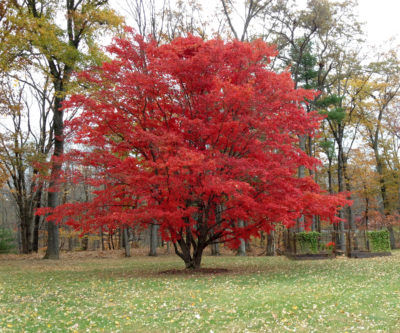
Japanese maple in fall
Bleeding sap generally does more harm to gardeners’ psyches than to plants’ physiologies. My grape and hardy kiwi vines bleed when I prune them this time of year, with no harm done. So why worry about harm to a maple?
(The bleeding of grapevines that climb the arbor over my patio does have one downside. It’s very pleasant to sit outdoors on that patio on warm, spring days; it’s very unpleasant to sit where sap drips on my head.)
Root pressure of water being forced up the vines is what makes grape and kiwi vines bleed. Once leaves unfold, they take up that pressure and bleeding ceases.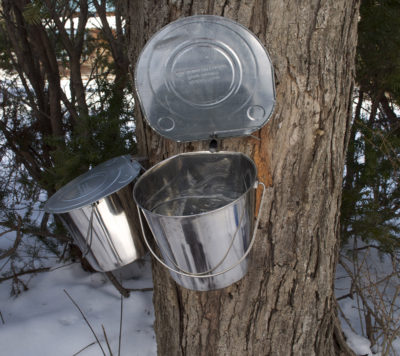
Root pressure is not what forces sap (which sounds more benign than “bleeding”) out of wounds of maple trees. With maples, cooling temperatures cause gas bubbles in xylem cells (the inner ring of trees’ cells in which liquid is conducted upwards from the roots) to shrink and to dissolve. Something’s got to fill that newfound space, so more liquid is sucked up from the roots and into the cells. As temperatures drop further, ice forms and gases are locked within the developing ice. Come morning, pressure builds in the cells as rising temperatures melt the ice and release the gases. The expanding liquid is forced out any holes in the bark, whether from a maple sap spile or from a pruning wound.
Although maples bleed for a different reason than do most other plants, the bleeding itself causes no harm to the plants. The reason small maple trees, with trunks narrower than 6 inches in diameter, should not be tapped is because the wound left by the tap hole extends within the trunk beyond the hole; sap will never again travel past the wounded area. A tap hole is large in relation to the size of a small tree’s trunk, so significantly restricts liquid flow.
Of course, there’s no need to conduct sap up a trunk that’s been lopped off. So, Barbara, go ahead and prune, now, when the gaping wound can soon begin to heal. Autumn, which leaves a gaping wound exposed to the elements and pests until spring, would be a very bad time to prune.
A Wabbit!!!!
I looked out the window awhile ago to see a rabbit crouched against a backdrop of pure, white snow. How cute. NOT! It’s the same old story. Farmer McGregor and Peter Rabbit, and now farmdener me and some other rabbit.
A few days previously I had noticed that some bark had been nibbled off the pencil-thick “trunks” of some young, grafted trees — the handiwork of those awful furballs. That nibbling probably won’t kill the small plants but will set them back a year, or more, if the nibbling kills the scion down to the graft.
As for the rabbit and its probable kin, I’m setting traps. Unfortunately, my Peter Rabbit seems to enjoy my plants more than anything I put in the trap.
Rabbit, At Bay
I’ve kept my Peter Rabbit at bay from all my older trees this winter with diligence and hardware cloth and or commercially available plastic spiral tree guards. The protection goes 2 feet above ground, or higher, not that a rabbit could reach that high — except when there’s snow to give it “a leg up.” The light-colored spirals also protect the thin barks of young trees from sunscald, which results when sunny, cold winter days warm the bark, whose temperature then plummets as the sun drops below the western horizon.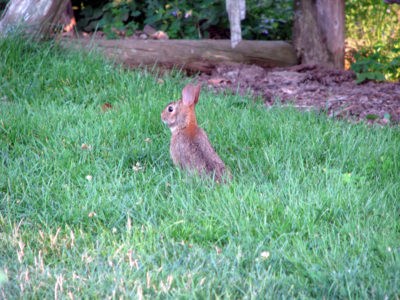
I remove all the spirals in spring so insects can’t find shelter from birds beneath the spirals.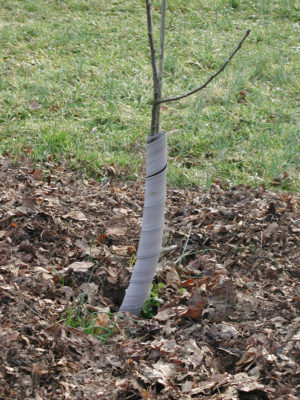
Monthly, throughout winter and into early spring, I also sprayed plants with Bobbex, a mix of “putrescent whole egg solids,” garlic, and cloves that is repellant to rabbits, as well as deer (and me).
And finally, there’s Sammy, my trusty dog who would chase away any rabbits if he happened to be awake, happened to be on the right side of the house, and happened to see them.

